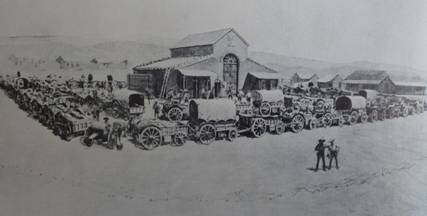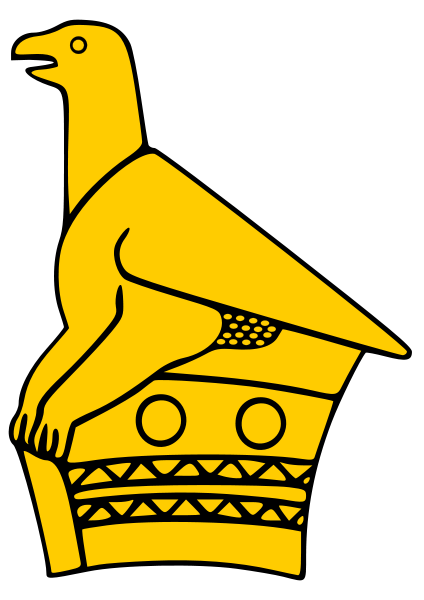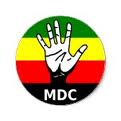Pioneer Days
Order restored?
Duncan and the War Council managed to restore some order by the next day, immediately making themselves hugely unpopular by ordering all bars in the town closed by 2000. (As the Rhodesia Weekly Review soberly reported, "it is a well-known and much regretted fact that there are in our community a certain number of men who invariably make any unusual event an excuse for drinking".) More proactively, the Council began the construction of the laager around Market Square that was to serve as refuge and meeting place for the duration of the war. It was surrounded with two rows of wagons chained together and packed with sandbags. Surrounding this were three separate barbed-wire fences and a belt of broken glass almost 30 metres wide, dotted with pyres ready to be lit to provide light in case of a night attack. Machine guns were mounted at each corner. A well was dug to supply water needs (it is the covered one in front of City Hall today and used to supply water to the neighboring fountain) and tanks erected to hold a reserve supply. Sykes (1897: 19) relates that when dynamite was used to dig the initial hole, several women gave birth prematurely out of simple fright.
The town hunkered down...

The completed laager around Bulawayo's Market Hall, 1896.
Several other Bulawayo landmarks were converted to military purposes: the Stock Exchange building became a hospital; the Bulawayo Club was taken as headquarters for Grey's Scouts; Memorial Hospital was fortified as a last reserve for the Afrikaner Corps; the prison on Grey Street (Robert Mugabe Way) became the town's northernmost outpost. Difficult times were ahead and the BSACo report (1898: 8) on conditions of resupply is enlightening: "The problem which lay before the Company at this time was how to send food supplies, forage, arms, ammunition and reinforcements to a population of over 4000 in a town 587 miles away from its railway base and besieged by an enemy numbering about 15,000 fighting men. The rinderpest had, at one stroke, destroyed not only the main source of the fresh meat and milk upon which the town had hitherto depended on for its food, but also the transport by which there requirements of the population had been served". In the best of traditions, prices in Bulawayo soared.
Let's have some details…
Hans Sauer relates that a 45kg bag of mealies was being sold for £60 instead of the usual price of 7/6 and that fresh meat was almost unobtainable. Sykes (1897: 30-31) provides a handy list of foods and costs at the time but unfortunately we don't know the regular prices.
Bulawayo Food Prices, 1896
| 12 Eggs | 74s |
| 1 cauliflower | 32s 6d |
| Bottle milk | 30s |
| 1 Chicken (live) | £1 |
| Large Bag Potatoes | £30 |
| 1lb Carrots, turnips, etc | 5s |
Sykes reported that the market never closed during the war and would net as much as £2000 a month!
The BSACo was forced to provide food for the townspeople (and let it be said, did so much against its wishes) and those who could afford it bought from the meager supplies of tinned food brought up with the mail coach. Herbert Henderson (1968; see below) noted that by early March whiskey was already 30/- a bottle. Henderson (1968: 47) claimed that “food was very scarce in Bulawayo. I had some donkeys in milk, and I found I was most popular about afternoon tea time as my friends could get donkey's milk in their tea”. (He also jokingly said that his donkeys lived on the optimistic fare of the Chronicle bulletins since they were never seen to eat anything else). On May 8, the Commissary-General for the BSACo reported that, in addition to full rations for 400 men for 10 days which were being kept in reserve for the provisioning of the Gwelo Patrol, there were only 90 bags of flour and 78 bags of meal and a small amount of "general groceries" in the Company's stores. Later, and we will discuss this more fully in the Matobo briefing, the whites made it policy to seek out and otherwise confiscate or destroy food supplies as one way of bringing the Matabele to heel.
Sourced from the Zanj Financial Network 'Zfn', Harare, Zimbabwe, email briefing dated 28 March 2011


 South Devon Sound Radio
South Devon Sound Radio Museum of hp Calculators
Museum of hp Calculators Apollo Flight Journal
Apollo Flight Journal Apollo Lunar Surface Journal
Apollo Lunar Surface Journal Cloudy Nights Classic Telescopes
Cloudy Nights Classic Telescopes The Savanna - Saffer Shops in London
The Savanna - Saffer Shops in London Linux Mint
Linux Mint Movement for Democratic Change
Movement for Democratic Change